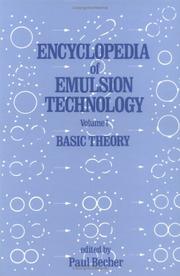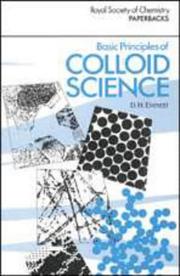| Listing 1 - 10 of 99 | << page >> |
Sort by
|
Book
Abstract | Keywords | Export | Availability | Bookmark
 Loading...
Loading...Choose an application
- Reference Manager
- EndNote
- RefWorks (Direct export to RefWorks)
Periodical
ISSN: 16083067 1061933X
Abstract | Keywords | Export | Availability | Bookmark
 Loading...
Loading...Choose an application
- Reference Manager
- EndNote
- RefWorks (Direct export to RefWorks)
Colloids --- Colloïdes --- 35.18 colloid and surface chemistry
Book
ISBN: 9783031132803 Year: 2022 Publisher: Cham, Switzerland : Springer,
Abstract | Keywords | Export | Availability | Bookmark
 Loading...
Loading...Choose an application
- Reference Manager
- EndNote
- RefWorks (Direct export to RefWorks)
Colloids --- Freezing. --- Colloid freezing --- Freezing colloids --- Freezing of colloids

ISBN: 0824718763 0824718771 9780824718763 Year: 1983 Publisher: New York M. Dekker
Abstract | Keywords | Export | Availability | Bookmark
 Loading...
Loading...Choose an application
- Reference Manager
- EndNote
- RefWorks (Direct export to RefWorks)
Emulsions --- Drug Industry --- Emulsions. --- Basic Sciences. Chemistry --- Physical Chemistry --- Colloid and Surface Chemistry --- Colloid and Surface Chemistry. --- Mixtures --- Separation (Technology)
Book
ISBN: 085404874X 9780854048748 Year: 1999 Volume: 112 Publisher: Cambridge : Royal Society of Chemistry,
Abstract | Keywords | Export | Availability | Bookmark
 Loading...
Loading...Choose an application
- Reference Manager
- EndNote
- RefWorks (Direct export to RefWorks)
Periodical
Abstract | Keywords | Export | Availability | Bookmark
 Loading...
Loading...Choose an application
- Reference Manager
- EndNote
- RefWorks (Direct export to RefWorks)
Colloid and Polymer Science is devoted to colloid and polymer science and its interdisciplinary interactions. As such, it responds to a demand which has lost none of its actuality as revealed in the trends of contemporary materials science.
Colloids --- Polymers --- Polymerization --- Colloïdes --- Polymères --- Colloïdchemie. --- Polymeren. --- Chemistry. --- Chemistry --- Polymer --- Hydrocolloids --- Colloid --- Hydrocolloid --- Micelles --- Liquid Crystals --- Colloid chemistry. --- Polymers. --- Colloids.

ISBN: 0851864430 9781847550200 1847550207 9781628704631 1628704632 9780851864433 Year: 1989 Publisher: London Royal Society of Chemistry
Abstract | Keywords | Export | Availability | Bookmark
 Loading...
Loading...Choose an application
- Reference Manager
- EndNote
- RefWorks (Direct export to RefWorks)
Book
ISBN: 1789235715 1789235707 1838815201 Year: 2018 Publisher: IntechOpen
Abstract | Keywords | Export | Availability | Bookmark
 Loading...
Loading...Choose an application
- Reference Manager
- EndNote
- RefWorks (Direct export to RefWorks)
This book covers new micro-/nanoemulsion systems in technology that has developed our knowledge of emulsion stability. The emulsion system is a major phenomenon in well-qualified products and has extensive usages in cosmetic industry, food industry, oil recovery, and mineral processes. In this book, readers will find recent studies, applications, and new technological developments on fundamental properties of emulsion systems.
Emulsions. --- Mixtures --- Separation (Technology) --- Physical Sciences --- Engineering and Technology --- Chemistry --- Physical Chemistry --- Colloid Science
Book
Year: 2021 Publisher: Delft TU Delft OPEN
Abstract | Keywords | Export | Availability | Bookmark
 Loading...
Loading...Choose an application
- Reference Manager
- EndNote
- RefWorks (Direct export to RefWorks)
This book is meant as an introduction to the field of colloid science, i.e. the study of the behaviour of micrometric particles in a fluid (or a gas). The book was written with a special emphasis on sediment particles. Sediment particles are complex colloidal particles due to their composition, shape and interaction with their environment.Characterization of the colloidal fraction of sediment is done by recording, among others, the particles’ size, shape and electric surface charge and evaluating their density or their interactions. These properties are important for civil engineering applications. Large-scale sediment transport models for example require as input the settling velocity of particles. In concentrated areas, this velocity becomes a function of the particles’ concentration and particle-particle interactions lead to the creation of larger particles, called flocs. These flocs can settle and, when reaching the bed, consolidate in time. All these aspects, and related models, are treated in the present book.
colloid --- clay --- sediment --- flocculation --- settling --- consolidation --- physico-chemistry --- DLVO theory --- rheology
Book
ISBN: 3798506914 0387912711 3798516987 Year: 1985 Volume: vol 71 Publisher: Darmstadt Steinkoff
Abstract | Keywords | Export | Availability | Bookmark
 Loading...
Loading...Choose an application
- Reference Manager
- EndNote
- RefWorks (Direct export to RefWorks)
678.01:541.18 --- Properties. Defects. Constitution. Serviceability. Sampling. Analysis. Testing-:-Colloid chemistry. Chemistry of adsorption phenomena. Capillary chemistry --- 678.01:541.18 Properties. Defects. Constitution. Serviceability. Sampling. Analysis. Testing-:-Colloid chemistry. Chemistry of adsorption phenomena. Capillary chemistry --- Polymères --- Polymeren.
| Listing 1 - 10 of 99 | << page >> |
Sort by
|

 Search
Search Feedback
Feedback About UniCat
About UniCat  Help
Help News
News